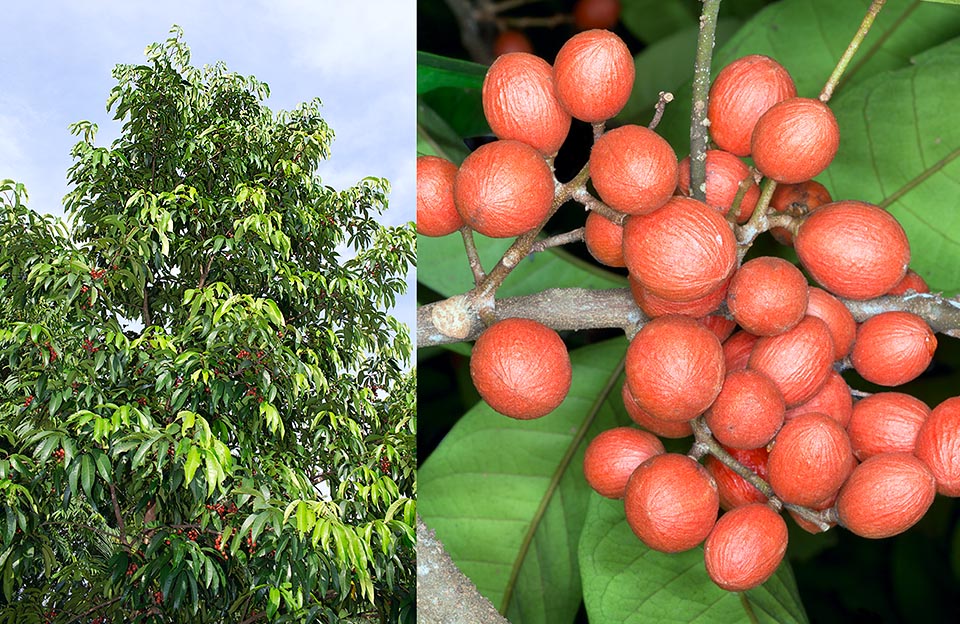Family : Meliaceae

Text © Pietro Puccio

English translation by Mario Beltramini
The species is native to Bhutan, Brunei, India (Assam), Indonesia (Kalimantan, Lesser Sunda Islands, Sulawesi and Sumatra), Malaysia (Peninsular Malaysia, Sabaj and Sarawak), Philippines and Thailand where it grows in the evergreen forests, often along the waterstreams, up to about 1700 m of altitude.
The name of the genus is the Greek substantive “ἀγλαία” (aglaia) = glory, beauty; the species is honoured to the Dutch botanist Pieter Willem Korthals (1807-1892).
Common names: korthal gisihan (Philippines); belajang merah, bilajang merah (Indonesia) kiah, piah, keriah, sekeriah, kriah, keriat (Peninsular Malaysia); langsat munchit (Sabah); segera (Sarawak); ke ya (Thailand).
The Aglaia korthalsii Miq. (1868) is an evergreen dioecious tree, up to 30 m tall, with trunk up to 70 cm of diameter, provided at the base of tabular roots (flattened roots similar to buttresses contributing to the support of big trees) up to 2 m tall, with more or less brownish bark, run at times by vertical fissures, and the young branches covered by thick reddish brown scales; all parts of the plant contain a white latex. The leaves, on a 7-10 cm long petiole, are odd-pinnate, up to about 30 cm long, with 5 elliptic leaflets (rarely 3 or 7) with pointed apex, 8-20 cm long and 3-8 cm broad, of intense green colour.

Aglaia korthalsii is a South-East Asia tree reaching 30 m of height almost unknown out from its origin countries. The 2-4 cm edible fruits are rich of vitamin C. Often cultivated in the villages, contains compounds known as flavaglines with insecticidal, antifungal, anti-inflammatory and anticancer properties © Giuseppe Mazza
The inflorescences, on short peduncle, are axillar, the male ones up to 30 cm long, the female usually shorter, with tiny 5-petals yellowish flowers, of 1,6-2,5 mm of diameter. The fruits are globose, 2-4 cm long and of about 3 cm of diameter, orange red when ripe, containing 2-3 ellipsoid seeds, 1,5-2 cm long, with juicy, translucid, yellowish, about 2 mm thick, edible, aril.
It reproduces by seed in draining and aerated loam maintained humid at the temperature of 24-26 °C.
Almost unknown out from its origin countries, it is often cultivated in the villages due to the fruits rich of vitamin C. The wood, pale pink to pale yellow, is locally used in the constructions and for realizing handicrafts items. The species, like all others of the genus Aglaia, contains compounds, known as flavaglines, that are under study because of their promising insecticidal, antifungal, anti-bacterial, anti-inflammatory and anticancer properties.
Synonyms : Hearnia aquatica Pierre (1895); Aglaia aquatica (Pierre) Harms (1896); Aglaia cauliflora Koord. (1898); Aglaia celebica Koord. (1898); Aglaia dysoxylifolia Koord. (1898); Aglaia dysoxylonoides Koord. (1898); Aglaia longipetiolulata Baker f. (1924); Aglaia confertiflora Merr. (1929).
→ To appreciate the biodiversity within the MELIACEAE family please click here.
